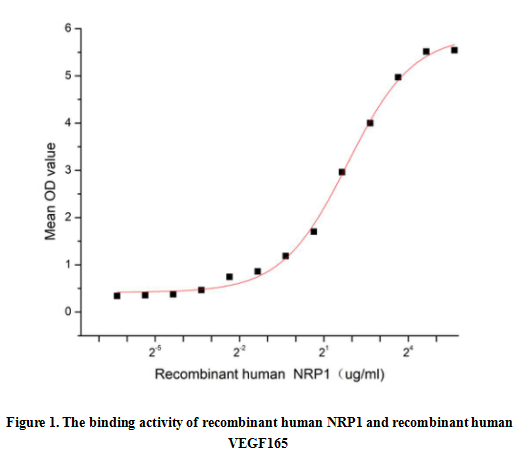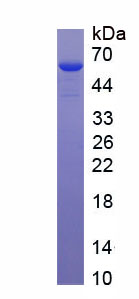Active Neuropilin 1 (NRP1) 

CD304; BDCA4; VEGF165R; Vascular endothelial cell growth factor 165 receptor
- UOM
- FOB US$ 240.00 US$ 600.00 US$ 1,200.00 US$ 3,600.00 US$ 9,000.00
- Quantity
Overview
Properties
- Product No.APA692Hu61
- Organism SpeciesHomo sapiens (Human) Same name, Different species.
- ApplicationsCell culture; Activity Assays.
Research use only - DownloadInstruction Manual
- CategoryNeuro scienceDevelopmental science
- Buffer FormulationPBS, pH7.4, containing 5% Trehalose.
- Traits Freeze-dried powder, Purity > 95%
- Isoelectric Point4.9
Sign into your account
Share a new citation as an author
Upload your experimental result
Review

Contact us
Please fill in the blank.
Activity test

Neuropilin 1 (NRP1), as kown as CD304 or VEGF165R, is a 130 - 140 kDa type I transmembrane (TM) glycoprotein. NRP1 is expressed by neurons, blood vessels, immune cells and many other cell types in the mammalian body and binds a range of structurally and functionally diverse extracellular ligands to modulate organ development and function. VEGF165, an angiogenic cytokine, has higher affinity for NRP1. A functional binding ELISA assay was conducted to detect the interaction of recombinant human NRP1 and recombinant human VEGF165. Briefly, NRP1 was diluted serially in PBS with 0.01% BSA (pH 7.4). Duplicate samples of 100 μl were then transferred to VEGF165-coated microtiter wells and incubated for 1h at 37℃. Wells were washed with PBST and incubated for 1h with anti-NRP1 pAb, then aspirated and washed 3 times. After incubation with HRP labelled secondary antibody for 1h at 37℃, wells were aspirated and washed 5 times. With the addition of substrate solution, wells were incubated 15-25 minutes at 37℃. Finally, add 50 µL stop solution to the wells and read at 450/630 nm immediately. The binding activity of recombinant human NRP1 and recombinant human VEGF165 was shown in Figure 1, the EC50 for this effect is 3.6 ug/mL.
Usage
Reconstitute in 10mM PBS (pH7.4) to a concentration of 0.1-1.0 mg/mL. Do not vortex.
Storage
Avoid repeated freeze/thaw cycles. Store at 2-8°C for one month. Aliquot and store at -80°C for 12 months.
Stability
The thermal stability is described by the loss rate. The loss rate was determined by accelerated thermal degradation test, that is, incubate the protein at 37°C for 48h, and no obvious degradation and precipitation were observed. The loss rate is less than 5% within the expiration date under appropriate storage condition.
Increment services
-
 BCA Protein Quantification Kit
BCA Protein Quantification Kit
-
 Molecular Mass Marker for Protein
Molecular Mass Marker for Protein
-
 Monoclonal Antibody Customized Service
Monoclonal Antibody Customized Service
-
 Polyclonal Antibody Customized Service
Polyclonal Antibody Customized Service
-
 Protein Activity Test Experiment Service
Protein Activity Test Experiment Service
-
 Electrophoretic Mobility Shift Assay (EMSA) Experiment Service
Electrophoretic Mobility Shift Assay (EMSA) Experiment Service
-
 Buffer
Buffer
-
 Lentivirus Packaging Experiment Service
Lentivirus Packaging Experiment Service
-
 Adenovirus Packaging Experiment Service
Adenovirus Packaging Experiment Service
-
 Real Time PCR Experimental Service
Real Time PCR Experimental Service
-
 Spike RBD Protein (S-RBD)
Spike RBD Protein (S-RBD)
-
 Protein G
Protein G
-
 Protein A
Protein A
Citations
- Peritumoral brain edema in angiomatous supratentorial meningiomas: an investigation of the vascular endothelial growth factor A pathwayPubMed: 23398358
- Circulating Soluble Neuropilin-1 in Patients with Early Cervical Cancer and Cervical Intraepithelial Neoplasia Can Be Used as a Valuable Diagnostic BiomarkerPubmed:25873749
- Cytokine-CpG Motif Oligodeoxynucleotide Co-inoculation in the Murine Malaria Modelhandle:123456789
- Reduced Sympathetic Innervation in Endometriosis is Associated to Semaphorin 3C and 3FExpression.pubmed:27558236
- Serum concentrations of neuropilin-1 in women with endometriosisPubmed: 32069143
- Curcumin and LOXblock-1 ameliorate ischemia-reperfusion induced inflammation and acute kidney injury by suppressing the semaphorin-plexin pathway.Pubmed: 32603817
- SARS-CoV2 Induced Biochemical Mechanisms in Liver Damage and Intestinal Lesions.







